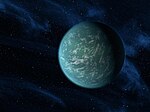astro.wikisort.org - Meteorite
WASP-39b, officially named Bocaprins, is a "hot Jupiter" extrasolar planet discovered in February 2011[3] by the WASP project, notable for containing a substantial amount of water in its atmosphere.[1][4][5] In addition, for the first time for any exoplanet, WASP-39b was found to contain carbon dioxide in its atmosphere.[6][7]
 Exoplanet WASP-39b found to contain substantial amounts of water in its atmosphere (artist's concept, not realistic because not to scale, and the unlit side should be red-hot).[1] | |
| Discovery | |
|---|---|
| Discovery site | WASP[2] |
| Discovery date | 2011[2] |
Detection method | Primary transit[2] |
| Orbital characteristics | |
Semi-major axis | 0.0486±0.0005 AU, (7.27±0.1)×106 km |
| Eccentricity | 0[2] |
Orbital period (sidereal) | 4.05526[2] d |
| Inclination | 87.83±0.25[2] |
| Star | WASP-39[2] |
| Physical characteristics | |
Mean radius | 1.27±0.04[2] RJ, (91±3)×103 km |
| Mass | 0.28±0.03[2] MJ |
Mean density | 180±40 kg m−3 |
WASP-39b is in the Virgo constellation, and is about 700 light-years from Earth.[1] As part of the NameExoWorlds campaigns at the 100th anniversary of the IAU, the planet was named Bocaprins, after the beach Boca Prins in the Arikok National Park of Aruba.
Characteristics

WASP-39b has a mass of about 0.28 times that of Jupiter and a radius about 1.27 times that of Jupiter (91,000 km).[2] It is a hot gas giant planet with a high temperature of 900 °C.[6] The exoplanet orbits very close (7 million km) to WASP-39, its host star, every 4 days.[1]
WASP-39b is also notable for having an extremely low density, near that of WASP-17b. While WASP-17b has a density of 0.13±0.06 g/cm3, WASP-39b has a slightly higher density of 0.18±0.04 g/cm3.
Atmospheric composition
![WASP-39b's atmospheric transmission spectrum captured by Webb’s Near-Infrared Spectrograph (NIRSpec) reveals first clear evidence for carbon dioxide in a planet outside the solar system.[6]](http://upload.wikimedia.org/wikipedia/commons/thumb/3/37/WASP-39b_Atmosphere_Composition.png/220px-WASP-39b_Atmosphere_Composition.png)
Hot water molecules were found in the atmosphere of WASP-39b in a 2018 study.[1] The atmospheric transmission spectra, taken by different instruments, were inconsistent as in 2021, possibly indicating a disequilibrium atmospheric chemistry.[8]
High-fidelity spectra obtained by JWST in 2022 did not confirm a disequilibrium chemistry. WASP-39b is the first exoplanet in which carbon dioxide has been detected.[6][9][7]
WASP-39 (star)
| Observation data Epoch J2000.0 Equinox J2000.0 (ICRS) | |
|---|---|
| Constellation | Virgo |
| Right ascension | 14h 29m 18.4151689656s |
| Declination | −03° 26′ 40.204480380″ |
| Apparent magnitude (V) | 12.09 |
| Distance | 702 ± 2 ly (215.4 ± 0.7 pc) |
| Other designations | |
2MASS J14291840-0326403, Gaia DR2 3643098875168270592, Gaia EDR3 3643098875168270592 | |
| Database references | |
| SIMBAD | data |
The parent star WASP-39 is of spectral class G and is slightly smaller than our own Sun. It lies in the Virgo constellation, 698 light-years from Earth.[1] The star WASP-39 was named Malmok.[10][11]
See also
- WASP-6b
- WASP-17b
- WASP-19b
- WASP-31b
- WASP-121b
- List of proper names of exoplanets (see section Sources in References)
- List of transiting exoplanets
- List of exoplanets discovered in 2011
References
- Cofield, Calla; Jenkins, Ann; Villard, Ray (1 March 2018). "NASA Finds a Large Amount of Water in an Exoplanet's Atmosphere". NASA. Retrieved 3 March 2018.
- "Planet WASP-39 b". Extrasolar Planets Encyclopaedia. 2018. Retrieved 1 March 2018.
- Faedi, F.; et al. (2011), "WASP-39b: A highly inflated Saturn-mass planet orbiting a late G-type star", Astronomy & Astrophysics, 531: A40, arXiv:1102.1375, Bibcode:2011A&A...531A..40F, doi:10.1051/0004-6361/201116671, S2CID 45385573
- Wakeford, H.R.; Sing, D.K.; Deming, D.; et al. (21 December 2017). "The Complete Transmission Spectrum of WASP-39b with a Precise Water Constraint". The Astronomical Journal. 155 (1): 29. arXiv:1711.10529. doi:10.3847/1538-3881/aa9e4e. S2CID 3685618.
- "NASA finds a large amount of water in an exoplanet's atmosphere". Phys.org. 1 March 2018. Retrieved 1 March 2018.
- Adkins, Jamie (25 August 2022). "NASA's Webb Detects Carbon Dioxide in Exoplanet Atmosphere". NASA. Retrieved 28 August 2022.
- Overbye, Dennis (26 August 2022). "Webb Telescope Sees a Carbon Dioxide Atmosphere Way Out There - WASP-39b, a distant world with a mass equivalent to Saturn's, is the first exoplanet known to harbor the gas". The New York Times. Retrieved 27 August 2022.
- Kawashima, Yui; Min, Michiel (2021), "Implementation of disequilibrium chemistry to spectral retrieval code ARCiS and application to 16 exoplanet transmission spectra", Astronomy & Astrophysics, 656: A90, arXiv:2110.13443, doi:10.1051/0004-6361/202141548, S2CID 239885551
- The JWST Transiting Exoplanet Community Early Release Science Team; et al. (2022), Identification of carbon dioxide in an exoplanet atmosphere, arXiv:2208.11692
- "Approved names". NameExoworlds. Retrieved 2 January 2020.
- "International Astronomical Union | IAU". www.iau.org. Retrieved 2 January 2020.
External links
![]() Media related to WASP-39b at Wikimedia Commons
Media related to WASP-39b at Wikimedia Commons
Другой контент может иметь иную лицензию. Перед использованием материалов сайта WikiSort.org внимательно изучите правила лицензирования конкретных элементов наполнения сайта.
WikiSort.org - проект по пересортировке и дополнению контента Википедии


